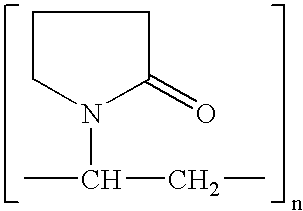Preparation of drug particles using evaporation precipitation into aqueous solutions
a technology of evaporative precipitation and drug particles, which is applied in the field of drug particles, can solve the problems of poor bioavailability, difficult to produce highly uniform submicron particles, and wet milling techniques that exhibit problems
- Summary
- Abstract
- Description
- Claims
- Application Information
AI Technical Summary
Problems solved by technology
Method used
Image
Examples
examples 1-8
[0063] The drug was cyclosporine, the organic was diethylether, and the concentration of the drug / organic mixture was 5.0 weight percent cyclosporine in diethylether. For the aqueous solution, Tween-80, a polyoxyethylene sorbitan monolaurate (ACROS) was a surfactant, or other excipient, which was used as the particle stabilizer. The drug / organic mixture was sprayed into 10 mL of aqueous solution at a rate of 1 ml / min. Table A lists processing parameters and the resulting particle sizes.
1TABLE A Drug / organic Aqueous Spray Tween-80 Median percent temp. temp time conc (wt particle particles Ex (.degree. C.) (.degree. C.) (min) percent) size (nm) <median size 1 65 55 10 1 470 11 2 65 55 10 1 608 64 3 65 65 10 1 1114 61 4 65 65 10 1 759 41 5 70 65 10 1 706 33 6 70 65 10 1 796 43 7 70 65 10 1 932 50 8 70 65 20 5 322 14
examples 9-13
[0064] The drug was cyclosporine, the organic was diethylether, and the concentration of the drug / organic mixture was as shown below in Table B. For the aqueous solution, phosphatidyl choline (10 wt percent), a Sigma egg lecithin, 60 percent pure, was a surfactant, or other excipient, used as a particle stabilizer. The drug / organic mixture was sprayed into 10 mL aqueous solution at a rate of 1 ml / min. The temperature of the aqueous solution is 75.degree. C., while the drug / organic mixture was sprayed into the aqueous solution at a temperature of 75.degree. C. Table B lists some processing parameters and the resulting particle sizes.
2TABLE B Drug conc Particle Drug conc in Spray in aqueous Drug / size organic soln time (mg / ml surfactant range Ex (wt percent) (min) water) ratio (nm) 9 1 20 14.5 0.13 135-390 10 2 19 30.8 0.28 120-575 11 5 10 37.1 0.33 90-300 12 5 10 34.9 0.32 215-590 13 10 6 29.7 0.30 170
examples 14-16
[0065] The drug was cyclosporune (5 wt percent), the organic solvent was that listed in Table C below. For the aqueous solution, Poloxamer 407(1 wt percent), also known as Lutrol-F127, a poly(ethylene)-poly(propylene) block polymer consisting of 73 percent of polyethylene glycol and 27 percent polypropylene glycol with an average molecular weight of 12,000 (BASF), was a surfactant, or other excipient, used as a particle stabilizer. The drug / organic mixture was sprayed into 25 mL aqueous solution at a rate of 1 ml / min. The temperatures of the aqueous solution and of the drug / organic mixture were 75.degree. C. Table C lists some processing parameters and the resulting particle sizes.
3TABLE C Drug conc in aqueous (mg / ml Drug / surfactant Particle size Ex Organic Solvent water) ratio range (nm) 4 Diethyl Ether 15 1.5 320-1000 15 Dichloromethane 17.8 1.78 160-345 16 Dichloromethane 14.8 1.48 196-202
PUM
| Property | Measurement | Unit |
|---|---|---|
| Length | aaaaa | aaaaa |
| Fraction | aaaaa | aaaaa |
| Fraction | aaaaa | aaaaa |
Abstract
Description
Claims
Application Information
 Login to View More
Login to View More - R&D
- Intellectual Property
- Life Sciences
- Materials
- Tech Scout
- Unparalleled Data Quality
- Higher Quality Content
- 60% Fewer Hallucinations
Browse by: Latest US Patents, China's latest patents, Technical Efficacy Thesaurus, Application Domain, Technology Topic, Popular Technical Reports.
© 2025 PatSnap. All rights reserved.Legal|Privacy policy|Modern Slavery Act Transparency Statement|Sitemap|About US| Contact US: help@patsnap.com



